TELL ME About It: AAC Learning with ‘If You Give a Mouse a Cookie’!
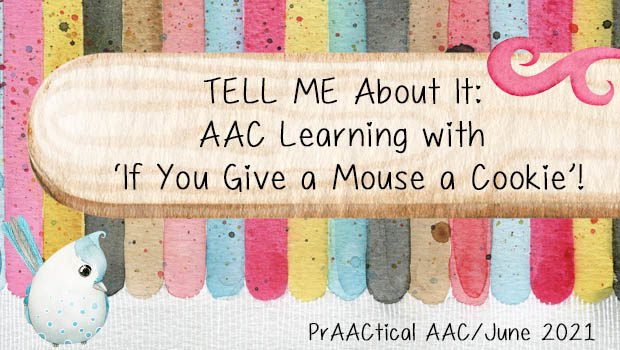
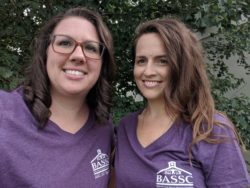 Ready for another post with book-related ideas for supporting core vocabulary learning in preschool classrooms? Today, we end another wonderful year of Jeanna Antrim and Maggie Judson’s TELL ME About It series with a terrific post featuring the book If You Give a Mouse a Cookie.
Ready for another post with book-related ideas for supporting core vocabulary learning in preschool classrooms? Today, we end another wonderful year of Jeanna Antrim and Maggie Judson’s TELL ME About It series with a terrific post featuring the book If You Give a Mouse a Cookie.
If you’re in search of ways to support preschool teachers who are implementing the TELL ME program with their young students, this post will give you lots of tried-and-true ideas. Maggie and Jeanna are speech-language pathologists who work in the Assistive Technology Department for the Belleville Area Special Services Cooperative (BASSC) in southern Illinois. They are AT/AAC facilitators and provide evaluations, direct therapy, consultations, and trainings with school teams.
:::::::::::::::::::::::::::::::::::::::::::::::::::::::::::::::::::::::::::::::::::::::::::::::::::
TELL ME About The Book
The last book in this series is “If You Give a Mouse a Cookie” by Laura Joffe Numeroff. Such a fun book that introduces a simple plot line to our students while still providing repetitive exposure to those oh-so-awesome core words. Connecting the story to background knowledge is very natural for this book, as the story takes place within the home around routine parts of the day such as eating, cleaning, sleeping, and reading. Another fun aspect of this book is the illustrations – the pictures are very colorful and detailed, which provides for a variety of communication opportunities during the picture walkthroughs and repeated readings you will be providing. 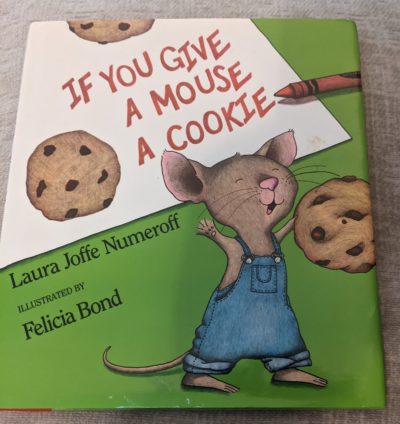
See below for the book focus for “If You Give a Mouse a Cookie”:
Book Focus:
- Core Words (BOW WOW Words): GIVE, GO, WANT, AWAY, SEE
- Additional Words (Tiger Talk Words): read, write, messy
- Concept Vocabulary: action words – ask, need, wash, read, look
- Book Concept: Books have a front, back, and an author
- Special Letters: i, s, b, l, e, r, w, k, x, v
TELL ME About Reading
Repeated Reading Focus: Student’s Retell the Story
Repeated readings offer an opportunity to work on all sorts of different literacy skills, which is why TELL ME recommends using the same book for two weeks (yay for repetition with variety!). Story retelling is a great extension activity to work on after one of your shared reading sessions. It guides you in addressing story comprehension skills, language, and communication skills, and, ultimately, how to help a student sequence and retell events that happen in their own lives.
“If You Give a Mouse a Cookie” is an excellent book to work on story retelling skills as the book has a strong plotline, a problem, a solution, and a beginning, middle, and end. Students in the preschool and early childhood special education classroom may benefit from using pictures or props to work on story retelling. These visuals provide the necessary support to recall characters and events in the book as they sequence the plot and retell the story. An easy way to provide such support is with picture story props. Students can manipulate and organize the pictures to order the story’s events and retell the story. Yay for visuals!
Adaptation Idea: Use the Illustrations in the Book to “Add” Visuals for the Fringe Vocabulary
Taking the time to adapt a book can have a big payoff during your shared reading interactions. But by thinking through what specific adaptations your students and caseload need will provide even more of a benefit! There are so many different ways you can change a book to make it more accessible for a student, but not every student will need every modification. Thinking about what your students specifically need to have modified in a book will help them access it while keeping your prep time manageable.
One beneficial book adaptation that is great for any book (and totally no prep!) is to use the story illustrations already in the book to “add” visual support to the text. It is so super simple and quickly provides visual supports on the fly. What you do is: point to the word in the text + then point to the picture of that word in the illustration + then point to the word again. That’s it! This strategy is very useful for a story’s fringe vocabulary, as the visuals for many of these words may already be in the book!
Check this out in action in this video from last month’s post.
TELL ME About Writing
Writing is a big part of a TELL ME classroom! See below for ideas:
Predictable Chart Topic
Title: If You GIVE a Mouse a Cookie.
Sentence frame: They will WANT a ___________.
FUNctional Writing Activity
Heelllloooo summer! Warmer weather makes for the perfect opportunity to switch up your FUNctional writing activities by taking them on the go and outside. Whether your school year goes all the way until the end of June, you are prepping for extended school year, sending home summer ideas, or getting your summer schedule ready for continued writing instruction, a great idea is to make a Nature Hunt Remnant Book.
A remnant book is like a memory book or scrapbook. It makes for a very motivating and meaningful writing and reading activity since it is all about an experience the student participated in. And motivating and meaningful are the name of the game when planning emergent literacy experiences #literacybillofrights !
- Step 1 – take your AAC to go on a scavenger hunt! You can work in all those good core words we are focusing on:
- “Let’s GO on a nature hunt!”
- “I wonder what we will SEE?”
- “I WANT that pretty rock”
- “You are reaching for it, I think you WANT me to GIVE it to you”
- “Let’s put it AWAY in the bag to take with us!”
- Step 2 – take your AAC back inside, along with all your nature finds (like leaves, flowers, rocks, sticks, moss, pine cones), to do some writing to make a remnant book.
- Step 3 – We make remnant book writing extra easy by prepping with a ready-to-go template – aka attaching multiple pencil pouches (or plastic bags) with binder rings to form a “book”. It’s a great way to pre-plan so that you can focus on the fun part – collecting the remnants and talking, writing, and reading about them!
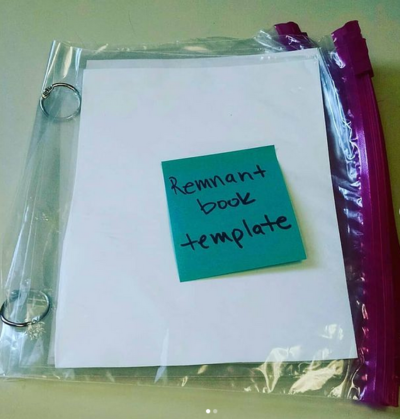
You can read more about remnant books here and here.
TELL ME More
Below are some specific ideas on how to implement “If You Give a Mouse a Cookie!” in your therapy sessions and classrooms TELL ME-style!
Aided Language Input Tip – Set Goals for Yourself/Challenging Others
Providing aided language input is one of those instructional strategies you will find yourself doing over and over (and over!) again in a TELL ME classroom. During all of this over and over again-ness, have you ever wondered about the quantity or quality of aided language input you are providing? One great way to up your aided language input game is to set a goal or challenge for yourself and your school team. This can be a great way to put extra focus on aided language input while keeping it fun and motivating for all the communication partners in the classroom or therapy room!
Set a goal that everyone will provide aided language input a certain number of times a day or during a specific lesson or for a certain number of language functions. Do a little pre-planning beforehand to make sure you have a focus for your challenge. To help, you can use a checklist like this or this from the SLP Nerdcast.
During the challenge, keep track by using a sticky note (like here) or a count clicker. Make it extra interactive with a fun activity like this from You Are My Speechie on Teachers Pay Teachers.
If you reach your goal or challenge, celebrate! Maybe have a staff pizza lunch or a Friday soda break to congratulate yourself and the team for upping your aided language input game. Make it fun, so everyone looks forward to the next challenge!
Embedding Core into the Daily Routine – Gross Motor Activities
Gross motor activities are typically a routine-based part of a preschool classroom, making them a natural time to incorporate the target core words into different rote phrases. Having some predetermined scripts can support communication partners as they become comfortable targeting core words and providing aided language input.
Some examples:
- “Yay, it’s time to GO play on the playground!”
- “I WANT to climb the ladder”
- “I SEE you looking at the ball, do you want to throw it?”
- “Throw it as far AWAY as you can!”
- “Can you GIVE me the ball so I can have a turn?”
- “Now you are hopping up and down, I think you WANT to jump”
Craft – Chocolate Chip Cookie Craft 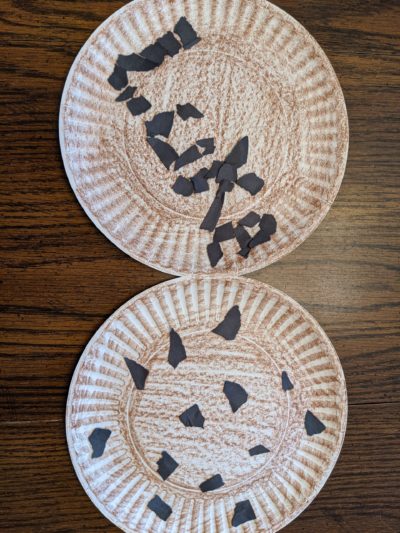
Materials:
- Paper Plate
- Brown Crayon or Marker
- Small, Black Torn Pieces of Paper
- Glue
Crafts and art projects can be a great way to create communication opportunities. Think of all of the communicative functions, such as requesting desired items, requesting assistance, directing actions, commenting, protesting, describing, labeling, asking/answering questions, that we can elicit and provide aided language input for! Some examples for the craft mentioned above could be:
- “GIVE me the glue, please.”
- “The black pieces GO on the brown plate.”
- “ I WANT to make my name with the chips.”
- “SEE mine?!”
Virtual Learning Resource – The AAC Coach Handouts and YouTube Channel
We love a good resource that teaches us new things, helping us grow as communication partners, and gives us easy access to materials to share with our teams and families. Enter the AAC Coach! She has a fabulous Instagram account where she shares resources for All. The. Information! Need to learn more about ….. (seriously, any AAC topic)? The AAC Coach has a handout for that! And she now has a YouTube channel with informative videos that you will find yourself rewatching and resharing constantly. Be sure to check out these resources and support the channel by subscribing!
BONUS Virtual Learning Resources!
- Check out Jeanna’s @speechwithoutlimits additional virtual learning resources! GO YouTube Video, GO Boom Deck, GIVE YouTube Video, GIVE Boom Deck, WANT YouTube Video, WANT Boom Deck, READ YouTube Video, READ Boom Deck, SEE YouTube Video, SEE Boom Deck, ALL YouTube Video, and ALL Boom Deck
- Check out Maggie’s @the.bookish.slp additional virtual learning resource! GO YouTube Videos, GO Boom Deck, GO Digital Book, WANT YouTube Videos, WANT Boom Deck, WANT Digital Book, SEE Digital Book
TELL ME at Home – Simple Shared Reading Tip: Find Print In The Environment
Last month, we talked about how one shared reading goal is to provide experiences around the alphabet and letter sounds all day long. Letter learning should be meaningful, interactive, and fun! One easy, natural way to do this is by pointing out all of the print, letters, and words we see in our environment as we go about our day. Easy, no-prep, and so engaging! Try:
- Pointing out words on traffic signs as you walk around the neighborhood
- Reading the names of stores as you drive by them
- Looking at our shirts that have pictures, drawings, and words on them while getting dressed
- Reading the labels of our food boxes and cans when making lunch
- Turning on the closed captions while watching a favorite show or video and reading along
- Reading out loud while writing a list for tomorrow’s grocery shop
- Sitting together to read texts from a family member and reading out loud while you write back
- Looking at the letters and words on soap and shampoo bottles while playing in the bath
Self-Reflection Tip
Raise your hand if you just absolutely love taking a good hard look at your teaching practices to see where you need to put time and effort into improving. Yeah, us not so much either! But though it can be uncomfortable (Ummm, watching a recording of yourself conducting a lesson or therapy session… yikes!), self-reflection is a meaningful way to change and improve your therapy or instructional practice. When you take the time to ask yourself questions, you can more easily see what areas you are rocking and what areas need your attention. Taking the time to reflect can help you set priorities for yourself, and we promise that it gets easier the more you do it!
The TELL ME program is all about helping us as educators develop good AAC teaching practices and routines that we can then implement when planning other lessons. But to do this, we have to reflect on how we are providing instruction. Self-reflection allows us to analyze what we are doing well and what we need to improve on, and we love that the TELL ME program provides daily self-reflection forms to more easily do this.
We hope that this portion of our blog series helped to make self-reflection a little easier and a little more part of your daily practice over the last year!
———————————————————————————————————————
RESOURCES and REFERENCES
Aided Language Stimulation video – Icpsat: https://www.youtube.com/watch?v=flFNMky22-U&feature=emb_logo
You can purchase the TELL ME manual from the Attainment Company (www.attainmentcompany.com/) or from ASHA (bit.ly/2XF1w1r).
You can learn more about the program by watching the webinar TELL ME: AAC for the Preschool Classroom presented by Dr. Carole Zangari, available from Saltillo (bit.ly/2RNpykn).
Check out the videos of us reading the book “If You Give a Mouse a Cookie” while providing aided language input:
https://www.youtube.com/watch?v=Zx5DhDfKSYg
:::::::::::::::::::::::::::::::::::::::::::::::::::::::::::::::::::::::::::::::::::::::
Follow us on Instagram @basscAAC and subscribe to our YouTube channel (basscAAC) for more AAC implementation ideas!
To read more about how we prepare for a TELL ME week, check out our previous posts in the TELL ME About It series!
We’re incredibly grateful to these talented professionals for lending us their expertise, time, and effort for this wonderful series.
- YEAR 1
- YEAR 2
Filed under: Featured Posts, PrAACtical Thinking
This post was written by Carole Zangari
